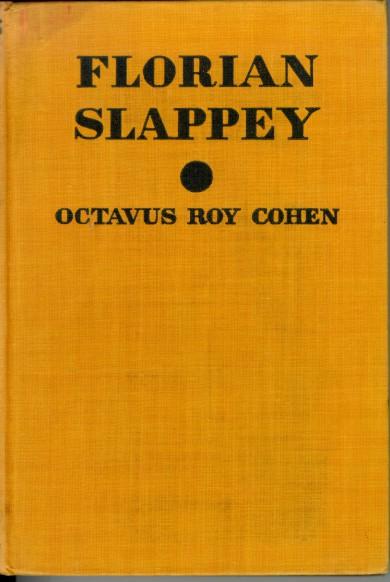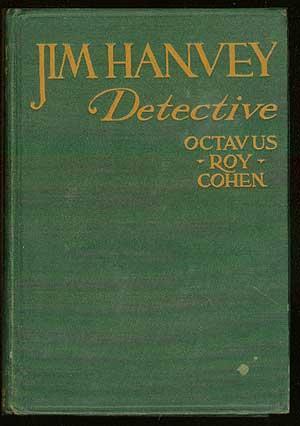|
A
NOTE ON OCTAVUS ROY COHEN, by Jon Breen
 In a renewed effort to
clear some shelf space, I confidently turned to Octavus Roy Cohen
(1891-1959). True, I recalled enjoying some of his magazine
short stories years ago, but in the ballgame of literary reputation, he
has at least two strikes against him. In a renewed effort to
clear some shelf space, I confidently turned to Octavus Roy Cohen
(1891-1959). True, I recalled enjoying some of his magazine
short stories years ago, but in the ballgame of literary reputation, he
has at least two strikes against him. He is remembered if at all for egregious comic stereotypes of African Americans, as in the series about sometime-detective Florian Slappey. However benignly this Negro dialect humor may have been intended, let’s just say it is not likely to be reprinted any time soon. In an unusual and unsuccessful experiment, Cohen’s radio serial The Townsend Murder Mystery (1933) was published in book form the same year it was broadcast coast to coast (from WJZ’s New York studios) on NBC. However it played on the air, it doesn’t work as a print mystery. That two comic-relief black characters were brought in for routines in exaggerated dialect in every episode is understandable – Cohen was famous for his “negro stories” per the publisher’s jacket copy, and AMOS ’N’ ANDY were a sensation on radio at the time – but it adds to the distress of the present-day reader. To test whether I wanted to persevere with Cohen, I read three novels about his first series sleuth, David Carroll (small, energetic, and relatively colorless), and two about his better-known Jim Hanvey (fat, languid, and folksy). Despite their differences, the two sleuths have much in common: they have such a high reputation as private detectives that official police turn over the running of their cases to them with nary a qualm; an emphasis on their humanity, including a friendly approach to witnesses and suspects; and a tendency (like many sleuths of the period) to enigmatically hold back their conclusions until ready to break the case. Intrigued by a reference on Mike Grost’s great website, A Guide to Classic Mystery and Detection, I started with Six Seconds of Darkness (copyright 1918 but published as a book in 1921), Carroll’s first case, though apparently third in book form. No sooner has the shooting murder of civic reformer Edward Hamilton been reported to police headquarters in an unnamed city, than people start turning up to confess: Eunice Duval, the victim’s ward; Frederick Badger, an old man nursing a grievance; and Vincent Harrelson, an artist and Eunice’s fiancé. Police Commissioner Hall promptly puts Carroll, a boyish-looking 38-year-old whose probe of police corruption had made him understandably unpopular at headquarters, in charge of the case, over the head of Chief of Detectives Barrett Rollins, whose own suspect, admitted burglar Red Hartigan, was on the scene but denies having killed Hamilton. The question of who fired when with what at whom during those six seconds someone turned the lights out keeps the reader guessing along with the sleuths. For a writer known as a humorist, Cohen provides surprisingly few laughs – note that his contemporary Carolyn Wells, another humorist who was a prolific detective novelist, cautioned that humor and detection don’t go together – but there are some amusing moments in the relationship of Carroll and Rollins, somewhat anticipating Philo Vance’s encounters with Sgt. Heath, if far less friendly. The plot is cleverly worked out, albeit extremely unlikely, with a satisfying surprise killer. The extensive criminal slang seems quaint now but was no doubt closer to actual underworld usage at the time Cohen was writing. All that’s missing, as Grost points out, are the fair-play clues that later Golden-Age writers would provide their readers. The second Carroll case, The Crimson Alibi (1919), is indeed a fully clued detective novel and both it and Midnight (1922), the last of Carroll’s four cases, were cleverly constructed and highly readable mysteries of their time. The humor quotient gradually increased: in the latter book, a 17-year-old girl of the post-WWI generation, strikes both a comic and a realistic note. By the time I got around to the two Jim Hanvey novels, The Backstage Mystery (1930), set in the theatrical world, and Star of Earth (1932), with a Hollywood movie industry background, I decided I had to keep Octavus Roy Cohen around for a while, even add to my holdings. The effort to clear the shelves had failed!
OCTAVUS ROY COHEN, A
BIBLIOGRAPHY - compiled by Steve Lewis
Book fiction only. Series characters: DC = David Carroll, JH - Jim Hanvey, FS = Florian Slappey, EP = Eric Peters, MG = Lt. Max Gold, MW = Lt. Marty Walsh. ss = story collection. * = marginal crime content. The Other Woman, with J. U.
Giesy. Macaulay, 1917.
Sources: Allen J. Hubin, Crime Fiction IV.The Crimson Alibi. Dodd Mead, 1919. [DC] Grosset & Dunlap, hc, –. [Includes photos of scenes from the play.] Jacobsen Publishing Co., hc, 1930. Gray Dusk. Dodd Mead, 1920. [DC] Grosset & Dunlap, hc, –. Six Seconds of Darkness. Dodd Mead, 1921. [DC] Grosset & Dunlap, hc, –. * Assorted Chocolates. Dodd Mead, 1922 [ss] Midnight. Dodd Mead, 1922. [DC] Grosset & Dunlap, hc, –. Jim Hanvey, Detective. Dodd Mead, 1923. [ss, JH]  The Iron Chalice. Little Brown, 1925. Grosset & Dunlap, hc, –. * Detours. Little Brown, 1927. [ss, JH in one] The Outer Gate. Little Brown,1927. Grosset & Dunlap, hc, –. * Florian Slappey Goes Abroad. Little Brown, 1928 [ss, FS] The May Day Mystery. D.Appleton, 1929 [JH] Grosset & Dunlap, hc, –. The Backstage Mystery. D.Appleton 1930. [JH] Grosset & Dunlap, hc, as Curtain at Eight, 1933. [Photoplay edition.] Green #14, digest-sized pb, 1945. Eric Peters, Pullman Porter. D.Appleton, 1930. [ss, EP] Cameos. D.Appleton, 1931. [ss] Carbon Copies. D.Appleton, 1932. [ss; four with FS] Star of Earth. D.Appleton, 1932. [JH] The Townsend Murder Mystery. D.Appleton, 1933. [Radio play published in book form.] Scrambled Yeggs. Appleton-Century, 1934. [ss, JH] Child of Evil. Appleton-Century, 1936. I Love You Again. Appleton-Century, 1937. Popular Library #196, pb, as There’s Always Time to Die, 1949. East of Broadway. Appleton-Century, 1938. Florian Slappey. Appleton-Century, 1938. [ss, FS] Strange Honeymoon. Appleton-Century, 1939. Romance in Crimson. Appleton-Century, 1940. Popular Library #74, pb, as Murder in Season, 1946. Lady in Armor. Appleton-Century, 1941. Sound of Revelry. Macmillan, 1943. Popular Library #43, pb, 1945. Romance in the First Degree. Macmillan, 1944. Popular Library #88, pb, 1946. Danger in Paradise. Macmillan, 1945. [MG] Popular Library #144, 1948. Dangerous Lady. Macmillan, 1946. Popular Library #264, pb, 1950. Love Has No Alibi. Macmillan, 1946. [MG] Popular Library #162, pb, 1948. Don’t Ever Love Me. Macmillan, 1947. [MG] Popular Library #332, pb, Apr 1951. More Beautiful Than Murder. Macmillan, 1948. [MW] Popular Library #427, pb, 1952. My Love Wears Black. Macmillan, 1948. [MW] Popular Library #369, pb, 1951. A Bullet for My Love. Macmillan, 1950. [MW] Popular Library #462, pb, 1952. The Corpse That Walked. Gold Medal #138, pb, 1951. Gold Medal #650, 1957. Lost Lady. Gold Medal #172, pb, 1951. Love Can Be Dangerous. Macmillan, 1955. Graphic #125, pb, as The Intruder, 1956. www.abebooks.com Comment/Inquiry: What other author(s) whose career(s) began in the 1910’s concluded by writing paperback originals in the 1950s or 60s? _____________________________________ YOUR COMMENTS ARE WELCOME. This article first appeared in Mystery*File 46, November 2004. Copyright © 2004 by Steve Lewis. All rights reserved to contributors. Bibliography copyright © 2005 by Steve Lewis.
Return to
the Main Page.
|